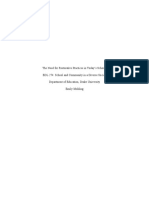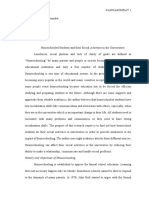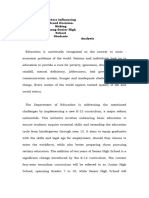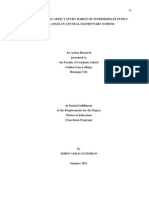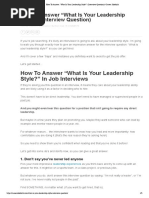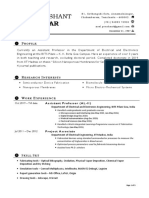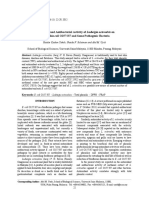0 ratings0% found this document useful (0 votes)
Literature Review
Literature Review
Uploaded by
bridellepagaThis document discusses research on student behavior and the use of Facebook. It summarizes that Facebook aims to connect people and allow sharing of information and ideas. Studies find billions of monthly and daily active Facebook users worldwide, including a large number in the Philippines who use it to share culture. Students are major users and research has found both benefits and drawbacks of social media use. The document then discusses frameworks for classifying and addressing undesirable student behaviors, including interventions, monitoring, and sanctions, as well as understanding factors that influence behaviors. Overall approaches to managing behaviors and reducing negative impacts are recommended.
Copyright:
© All Rights Reserved
Available Formats
Download as DOCX, PDF, TXT or read online from Scribd
Download as docx, pdf, or txt
Literature Review
Literature Review
Uploaded by
bridellepaga0 ratings0% found this document useful (0 votes)
This document discusses research on student behavior and the use of Facebook. It summarizes that Facebook aims to connect people and allow sharing of information and ideas. Studies find billions of monthly and daily active Facebook users worldwide, including a large number in the Philippines who use it to share culture. Students are major users and research has found both benefits and drawbacks of social media use. The document then discusses frameworks for classifying and addressing undesirable student behaviors, including interventions, monitoring, and sanctions, as well as understanding factors that influence behaviors. Overall approaches to managing behaviors and reducing negative impacts are recommended.
Copyright
© © All Rights Reserved
Available Formats
DOCX, PDF, TXT or read online from Scribd
Share this document
Did you find this document useful?
Is this content inappropriate?
This document discusses research on student behavior and the use of Facebook. It summarizes that Facebook aims to connect people and allow sharing of information and ideas. Studies find billions of monthly and daily active Facebook users worldwide, including a large number in the Philippines who use it to share culture. Students are major users and research has found both benefits and drawbacks of social media use. The document then discusses frameworks for classifying and addressing undesirable student behaviors, including interventions, monitoring, and sanctions, as well as understanding factors that influence behaviors. Overall approaches to managing behaviors and reducing negative impacts are recommended.
Copyright:
© All Rights Reserved
Available Formats
Download as DOCX, PDF, TXT or read online from Scribd
Download as docx, pdf, or txt
0 ratings0% found this document useful (0 votes)
Literature Review
Literature Review
Uploaded by
bridellepagaThis document discusses research on student behavior and the use of Facebook. It summarizes that Facebook aims to connect people and allow sharing of information and ideas. Studies find billions of monthly and daily active Facebook users worldwide, including a large number in the Philippines who use it to share culture. Students are major users and research has found both benefits and drawbacks of social media use. The document then discusses frameworks for classifying and addressing undesirable student behaviors, including interventions, monitoring, and sanctions, as well as understanding factors that influence behaviors. Overall approaches to managing behaviors and reducing negative impacts are recommended.
Copyright:
© All Rights Reserved
Available Formats
Download as DOCX, PDF, TXT or read online from Scribd
Download as docx, pdf, or txt
You are on page 1/ 5
LITERATURE REVIEW
The core purpose of Facebook has always been to connect people.
Facebook is a means to identify and connect with friends, as well
as keep up with their latest activities. Facebook is used to develop
and organize communities of interest on virtually any issue. It's a
platform that allows like-minded people to connect, share ideas,
discuss, and organize. (Sean Michael Kerner, n.d.) According to
Rohit Shewale (2024), Facebook presently has 3.05 billion
monthly active users and is expected to reach 3.07 billion by the
first quarter of 2024. And 2.064 billion people use Facebook every
day, accounting for 68.11% of the platform's monthly active users.
Furthermore, Facebook is a social powerhouse in the Philippines,
with an estimated 80.3 million users. The platform's purpose
extends beyond communication; it is a location where Filipinos
can exchange stories and images and celebrate their culture.
(Abigail Bosze, 2024). Students are among the millions of users.
Khrmangalam's website (www.krmangalamgurgaon.com)
provides a wealth of information regarding the benefits of social
media and Facebook, such as how social media has served as a
multifaceted tool for communication, information sharing, and
networking. Every school has used social media to help students
continue their education. Furthermore, it has allowed students to
collaborate with peers on group projects, share materials, and
seek assistance with academics. The most powerful feature of
social media is its ability to gather knowledge on a variety of
topics. Social media provides access to a wide selection of
educational content and news that can help students learn. Social
networking may be an effective tool for students looking to
investigate and pursue job options. Students can also use social
media to highlight their accomplishments, initiatives, and talents,
which may pique the interest of potential employers or colleagues.
However, there are certain negative consequences to utilizing
social media. We read it in the newspapers every day, hear it on
the news all the time, and get it online 24 hours a day, seven days
a week, thanks to Really Simple Syndication. The "it" is the news
about today's children, who are privileged, enjoy luxury, have
poor manners, despise authority, disrespect their elders, dispute
their parents, and tyrannize their teachers. We are also
continually informed that the world is going through difficult
circumstances, that young people today are self-centered,
impatient, and speak as if they know everything, and that what we
consider wisdom is foolishness to them. Paul A. Kirschner and
Aryn C. Karpinski, 2010. This study focuses on different grade
levels at Langkaan 2 National High School who may be
experiencing both positive and negative effects of Facebook use
that can influence their behavior.
Behavior management teaches pupils to be respectful to one
another, and everyone benefits from it. Effective behavior
management ensures that student behavior does not disturb
teaching, allowing teachers to teach and students to learn.
(Tylerport, n.d.) As a result, behavior management can have a
good impact on both your own and others' well-being.
Additionally, managing your own conduct may help reduce
negative impacts and poor behavior.
Siti Falindah Padlee et al. (2010) investigated the behavior of
overseas students in Malaysian private higher education
institutions. According to the research they conducted, any
behavior that does not support learning is considered undesirable.
Maplewell classifies undesirable behavior into three categories
based on its seriousness. Inappropriate behavior is defined as
low-level bad behavior that does not interfere with learning but is
out of place and would attract undesired attention if expressed in
the community, college, or business. Disruptive conduct refers to
any unpleasant behavior that stops or slows learning, whether in
the classroom, the larger learning environment, or in social
situations; challenging behavior refers to any activity that causes
or risks inflicting injury to themselves or others, as well as
property damage. Students with problematic behavior will require
extensive help from a variety of people, both inside and outside of
school, in order to lessen the dangers connected with their
behavior. As a result, they established three measures:
interventions, monitoring, and sanctions.
Interventions are consequences that promote constructive
behavior, establish proper incentive systems, and heal
relationships. An intervention could be a casual talk with a
member of staff or a systematic, timed program of planned
intervention given by professional intervention personnel. Other
beneficial approaches to assist students' conduct include a
personalized timetable and a change in tutor group. Monitoring is
another option for supporting a student's behavior. A student may
be assigned a report with a key member of staff, a mentor may be
identified, or a homeschool book may be used to track a student's
engagement and attitude. Interventions and monitoring are the
most effective ways to improve student behavior. However,
punishments are also necessary to ensure a safe, secure, and
controlled environment in which all kids can prosper. Approved
consequences include contacting parents via letter, phone, email,
or in person. Break or lunchtime detentions in which students
may be ordered to perform restorative chores such as repairing
damage, cleaning up graffiti, or writing an apology letter. Internal
reflection. Students will be supervised during the day and will
learn separately from other students. Students will have morning
and lunch breaks, but they will be supervised and separated from
their peers. Certain aspects of the work may be rehabilitative in
nature, with a specific focus on negative behavior. Furthermore,
Dana Dobrovskà's (2017) research findings revealed that negative
student behaviors such as procrastination, perfectionism, fear of
failure, task difficulty, low motivation, or laziness, among others,
may have an impact on academic performance.
To limit or effectively address these behaviors, it is critical to
understand the elements that generate or assist them. (Carnegie
Mellon University, n.d.) Students may participate in problematic
activities as a result of health problems, personal or family
problems, adjustment or developmental challenges (e.g.,
"immaturity" or low self-esteem), or general academic difficulties.
And there are several effective approaches to coping with these
habits. Sorcinelli (2002) recommends four concepts for reducing
occurrences.
First, set expectations from the start. Clearly communicating with
students how you want them to act in class helps to avoid
incidents caused by mismatched expectations. Define your
policies for the syllabus. Make effective use of your first day of
class. Allow students to set ground rules. Second, reduce
anonymity. Students, particularly in large courses, may engage in
careless behavior since the environment is quite depersonalized.
You might use a variety of strategies to establish connections with
students. Learn and use names consistently. Engage students one-
on-one. Take advantage of the office hours. Third, get feedback
from students. Some student incivilities are caused by perceived
instructor incivilities, such as the instructor's own tardiness or
disorganization, rudeness, or interruptions during student
discussions. Seek feedback to double-check the pupils'
perceptions of you. With one-minute sheets, you may conduct
early course evaluations or provide rapid anonymous feedback in
class. You can also designate some students as class
representatives and meet with them on a regular basis throughout
the semester so they can inform you of general student issues.
Finally, encourage active learning. Meaningful involvement
clearly enhances student learning and performance, but it can also
have an impact on student conduct in the classroom.
You might also like
- D5 Fortified Wines - An Accompaniment To The WSET Level 4 Diploma in Wines by Wine Spirit Education Trust100% (1)D5 Fortified Wines - An Accompaniment To The WSET Level 4 Diploma in Wines by Wine Spirit Education Trust74 pages
- MFD Part 2 - Pediatric Dentistry Qs & Answers0% (1)MFD Part 2 - Pediatric Dentistry Qs & Answers18 pages
- From Leadership in School Organization to Pragmatic Research in Physical Education Professional DevelopmentFrom EverandFrom Leadership in School Organization to Pragmatic Research in Physical Education Professional DevelopmentNo ratings yet
- The Effect of Bullying To The Academic Performance of Grade 12 Students in Lun Padidu National High School87% (15)The Effect of Bullying To The Academic Performance of Grade 12 Students in Lun Padidu National High School26 pages
- The Effects of Using Social Media While Online ClassesNo ratings yetThe Effects of Using Social Media While Online Classes15 pages
- Strengthening Social-Emotional Learning of Students Under New Normal Education Brought by The PandemicNo ratings yetStrengthening Social-Emotional Learning of Students Under New Normal Education Brought by The Pandemic8 pages
- Social Media Has Become An Integral Part of The Daily Lives of StudentsNo ratings yetSocial Media Has Become An Integral Part of The Daily Lives of Students2 pages
- A Critical Analysis of Acts of Student Indiscipline and Management Strategies Employed by School Authorities in Public High Schools in KenyaNo ratings yetA Critical Analysis of Acts of Student Indiscipline and Management Strategies Employed by School Authorities in Public High Schools in Kenya10 pages
- EFFECTS - OF - SOCIAL - MEDIA-WPS OfficeNo ratings yetEFFECTS - OF - SOCIAL - MEDIA-WPS Office17 pages
- Educational Planning Alcantara, KristineNo ratings yetEducational Planning Alcantara, Kristine3 pages
- Impacts of Social Media To The Behabviour Ofstudents in Rodirguez National High School Research Paper100% (7)Impacts of Social Media To The Behabviour Ofstudents in Rodirguez National High School Research Paper40 pages
- The Impact of Bullying in Junior High School: Vinanua, Leanne ErickaNo ratings yetThe Impact of Bullying in Junior High School: Vinanua, Leanne Ericka5 pages
- Action Research: Purpose, Problem Statement, Questions and Literature Review Joaquin Torres American College of EducationNo ratings yetAction Research: Purpose, Problem Statement, Questions and Literature Review Joaquin Torres American College of Education18 pages
- Behavioral Problems of Students Observed by The Secondary Teachers in The Classroom As A Basis For A Proposed Intervention SchemeNo ratings yetBehavioral Problems of Students Observed by The Secondary Teachers in The Classroom As A Basis For A Proposed Intervention Scheme6 pages
- The Influence of Peers Among Grade 9 Students at Saint Mark International Academy That Affects Their Academic Performance100% (3)The Influence of Peers Among Grade 9 Students at Saint Mark International Academy That Affects Their Academic Performance42 pages
- Assignment # 3 - Genre Writing - Essay Cyberbullying and Supporting The Safe and Ethical Use of Information and Communication Technology in SchoolsNo ratings yetAssignment # 3 - Genre Writing - Essay Cyberbullying and Supporting The Safe and Ethical Use of Information and Communication Technology in Schools6 pages
- Da Rocha Barros - Reflections On The Clinical Implications of SymbolismNo ratings yetDa Rocha Barros - Reflections On The Clinical Implications of Symbolism23 pages
- Medical Certification Form - New Driver Applicant: If You Have Any Questions, Please Visit Our Website AtNo ratings yetMedical Certification Form - New Driver Applicant: If You Have Any Questions, Please Visit Our Website At1 page
- Installation Video Operating Video Settings VideoNo ratings yetInstallation Video Operating Video Settings Video41 pages
- Sociology/Philippine Popular Culture For Higher Educational Institutions (Hei'S)No ratings yetSociology/Philippine Popular Culture For Higher Educational Institutions (Hei'S)9 pages
- How To Answer "What Is Your Leadership Style - " (Interview Question) - Career SidekickNo ratings yetHow To Answer "What Is Your Leadership Style - " (Interview Question) - Career Sidekick4 pages
- Antioxidant and Antibacterial Activity of Ludwigia Octovalvis OnNo ratings yetAntioxidant and Antibacterial Activity of Ludwigia Octovalvis On8 pages
- D5 Fortified Wines - An Accompaniment To The WSET Level 4 Diploma in Wines by Wine Spirit Education TrustD5 Fortified Wines - An Accompaniment To The WSET Level 4 Diploma in Wines by Wine Spirit Education Trust
- From Leadership in School Organization to Pragmatic Research in Physical Education Professional DevelopmentFrom EverandFrom Leadership in School Organization to Pragmatic Research in Physical Education Professional Development
- The Effect of Bullying To The Academic Performance of Grade 12 Students in Lun Padidu National High SchoolThe Effect of Bullying To The Academic Performance of Grade 12 Students in Lun Padidu National High School
- The Effects of Using Social Media While Online ClassesThe Effects of Using Social Media While Online Classes
- Strengthening Social-Emotional Learning of Students Under New Normal Education Brought by The PandemicStrengthening Social-Emotional Learning of Students Under New Normal Education Brought by The Pandemic
- Social Media Has Become An Integral Part of The Daily Lives of StudentsSocial Media Has Become An Integral Part of The Daily Lives of Students
- A Critical Analysis of Acts of Student Indiscipline and Management Strategies Employed by School Authorities in Public High Schools in KenyaA Critical Analysis of Acts of Student Indiscipline and Management Strategies Employed by School Authorities in Public High Schools in Kenya
- Impacts of Social Media To The Behabviour Ofstudents in Rodirguez National High School Research PaperImpacts of Social Media To The Behabviour Ofstudents in Rodirguez National High School Research Paper
- The Impact of Bullying in Junior High School: Vinanua, Leanne ErickaThe Impact of Bullying in Junior High School: Vinanua, Leanne Ericka
- Action Research: Purpose, Problem Statement, Questions and Literature Review Joaquin Torres American College of EducationAction Research: Purpose, Problem Statement, Questions and Literature Review Joaquin Torres American College of Education
- Behavioral Problems of Students Observed by The Secondary Teachers in The Classroom As A Basis For A Proposed Intervention SchemeBehavioral Problems of Students Observed by The Secondary Teachers in The Classroom As A Basis For A Proposed Intervention Scheme
- The Influence of Peers Among Grade 9 Students at Saint Mark International Academy That Affects Their Academic PerformanceThe Influence of Peers Among Grade 9 Students at Saint Mark International Academy That Affects Their Academic Performance
- Assignment # 3 - Genre Writing - Essay Cyberbullying and Supporting The Safe and Ethical Use of Information and Communication Technology in SchoolsAssignment # 3 - Genre Writing - Essay Cyberbullying and Supporting The Safe and Ethical Use of Information and Communication Technology in Schools
- Da Rocha Barros - Reflections On The Clinical Implications of SymbolismDa Rocha Barros - Reflections On The Clinical Implications of Symbolism
- Medical Certification Form - New Driver Applicant: If You Have Any Questions, Please Visit Our Website AtMedical Certification Form - New Driver Applicant: If You Have Any Questions, Please Visit Our Website At
- Sociology/Philippine Popular Culture For Higher Educational Institutions (Hei'S)Sociology/Philippine Popular Culture For Higher Educational Institutions (Hei'S)
- How To Answer "What Is Your Leadership Style - " (Interview Question) - Career SidekickHow To Answer "What Is Your Leadership Style - " (Interview Question) - Career Sidekick
- Antioxidant and Antibacterial Activity of Ludwigia Octovalvis OnAntioxidant and Antibacterial Activity of Ludwigia Octovalvis On





